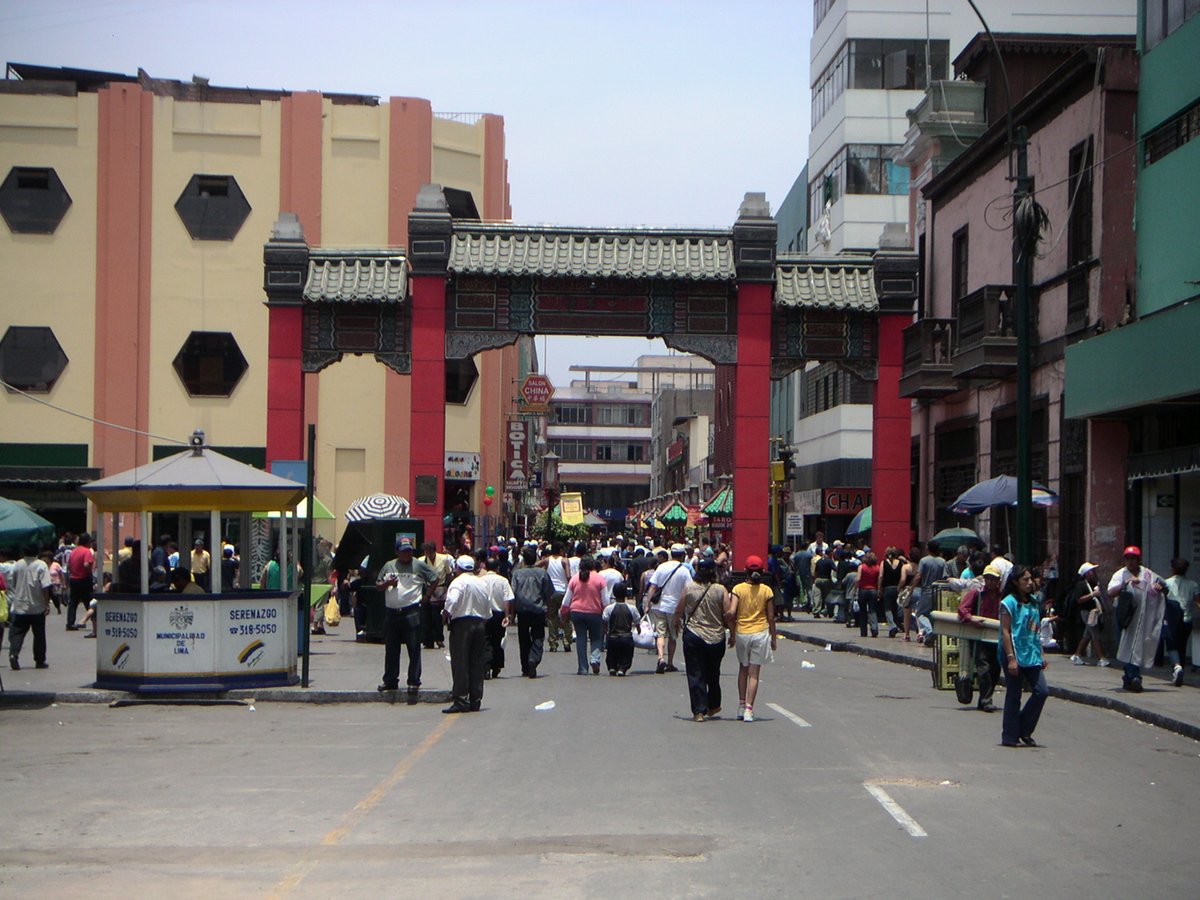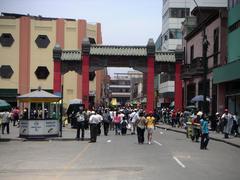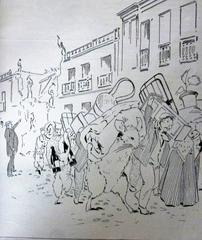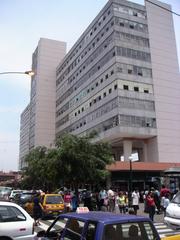
Barrio Chino Lima Peru: Visiting Hours, Tickets, and Historical Sites Guide
Date: 14/06/2025
Introduction
Nestled in Lima’s historic centre, Barrio Chino is a vibrant testament to the enduring fusion between Chinese and Peruvian cultures. Established in the mid-19th century by Chinese immigrants seeking new opportunities after the abolition of slavery, this neighborhood has grown from humble beginnings into one of Lima’s most dynamic cultural and culinary hubs. Visitors are welcomed by traditional Chinese architecture, iconic landmarks like the monumental Chinese Arch (Arco Chino), and the bustling Calle Capón—each reflecting a rich tapestry of history and intercultural exchange.
Open year-round and free to enter, Barrio Chino is easy to access, with most shops and restaurants operating from 10:00 AM to 9:00 PM. Special cultural sites or events may request small donations or tickets. The neighborhood’s central location near Lima’s Plaza Mayor means you can easily combine a visit here with other historical highlights. Throughout the year, Barrio Chino hosts vibrant festivals, including the Lunar New Year and Mid-Autumn Festival, which feature dragon dances, culinary fairs, and traditional performances.
Whether drawn by its storied past, unique architecture, or the irresistible aromas of chifa cuisine—a beloved Chinese-Peruvian fusion—visitors will find Barrio Chino an immersive experience for history buffs, foodies, and curious travelers alike. This guide provides all you need to explore its historical roots, cultural significance, practical visitor information, and travel tips (machutravelperu.com; Aracari; Free Walking Tours Peru; Voyage Perou).
Historical Overview
Early Origins and Chinese Immigration
Barrio Chino’s story begins in the 1850s, following the abolition of slavery in Peru. Thousands of Chinese laborers—mainly from Guangdong (Canton)—arrived to work on plantations, railroads, and in the guano industry. Many settled in Lima, gradually forming a community around what would become Calle Capón (machutravelperu.com; wikipedia.org).
Growth and Cultural Establishment
As the Chinese community expanded, so did the neighborhood’s vibrancy. Chinese-Peruvian life thrived with the creation of temples, benevolent societies, and new businesses. The emergence of chifa restaurants—a blend of Cantonese and Peruvian flavors—became a defining hallmark, with Barrio Chino at the movement’s heart (chinadailyhk.com; machutravelperu.com).
Challenges and Transformation
Barrio Chino faced adversity during the War of the Pacific and subsequent periods of discrimination and urban redevelopment. Despite setbacks—including government-ordered demolitions and a ban on Chinese immigration—resilience and adaptability allowed the community to survive and eventually revive. The late 20th century brought renewed growth, new waves of migration, and urban improvements, such as the pedestrianization and beautification of Calle Capón (wikipedia.org; medium.com).
Visiting Barrio Chino: Hours, Tickets, and Access
- General Hours: The neighborhood is open 24/7, but most shops, chifas, and markets operate from 10:00 AM to 9:00 PM daily.
- Tickets: No entrance fees are required to walk through Barrio Chino or visit the Chinese Arch. Some temples or festivals may request small donations or tickets.
- Getting There: Barrio Chino is centrally located and just a 10-minute walk from Plaza Mayor. It is accessible via public transit, taxi, or on foot (Free Walking Tours Peru; Voyage Perou).
- Accessibility: The main streets are pedestrian-friendly and suitable for visitors with limited mobility, though some older buildings may have restricted access.
Cultural and Historical Landmarks
Calle Capón
As the main artery of Barrio Chino, Calle Capón is renowned for its pedestrian-friendly layout, vibrant lanterns, and decorative motifs. It is the focal point for festivals and daily neighborhood life (Free Walking Tours Peru).
The Chinese Arch (Arco Chino)
This ornate gateway, gifted by the Chinese community in 1971, is adorned with dragons and traditional calligraphy. It stands as a prominent symbol of Chinese-Peruvian friendship and cultural pride (Free Walking Tours Peru).
Temples and Associations
While most temples are closed to the public, their facades and occasional festival open houses provide insights into the spiritual life of the community. Key associations include the Sociedad Central de Beneficencia China and Ku Kong Chao Association (Authentic Food Quest).
Culinary Experiences: Chifa Cuisine
Barrio Chino is the birthplace of Chifa, where Cantonese culinary traditions meet Peruvian ingredients. With over 6,000 chifas in Lima, the most authentic are found here (Authentic Food Quest).
Must-Try Dishes:
- Arroz Chaufa: Peruvian fried rice with a local twist.
- Tallarín Saltado: Stir-fried noodles with vegetables and meats.
- Sopa Wantán: Wonton soup, a classic starter.
- Pollo Chi Jau Kay: Crispy chicken with sweet-savory sauce.
Notable Restaurants:
- Chifa San Joy Lao: A historic favorite (El Comercio).
- Chifa Wa Lok: Known for dim sum and Peking duck.
Street Food and Bakeries: Enjoy Chinese-Peruvian pastries, buns, and sweet treats from local bakeries and vendors.
Food Tours: Guided tastings and culinary tours reveal the history and evolution of Chifa cuisine (Authentic Food Quest).
Festivals and Community Events
Chinese New Year
Barrio Chino’s most anticipated event, Chinese New Year, features dragon and lion dances, fireworks, parades, and traditional music. Workshops, exhibitions, and cultural talks are often free during festival periods (RPP; El Comercio; Panamericana).
Other Festivals
The Mid-Autumn Festival and other traditional holidays are celebrated with lantern displays, mooncakes, and public performances.
Shopping and Souvenirs
Barrio Chino is home to specialty shops selling teas, herbs, porcelain, and festive decorations. Local markets offer Asian spices, fresh produce, and ingredients essential to Chifa cuisine.
Art, Architecture, and Urban Identity
The district’s visual character is defined by a blend of Chinese and colonial architectural styles, colorful murals, and public art installations depicting migration, prosperity, and good fortune (Free Walking Tours Peru). The twelve white octagons on Calle Capón’s pavement represent the Chinese zodiac.
Safety and Practical Tips
- Safety: Barrio Chino is generally safe by day, but remain vigilant against pickpockets, especially in crowds. Avoid nearby high-crime areas and use authorized taxis at night (Travellers Worldwide; Reddit).
- Language: Spanish is predominant; some locals speak Cantonese or Mandarin. English is less common.
- Best Times to Visit: Weekends and festival periods are most lively, but weekday mornings offer a quieter atmosphere.
- Guided Tours: Free and paid walking tours provide deeper insight and safe exploration (Free Walking Tours Peru).
Nearby Attractions
Due to its central location, Barrio Chino is an ideal starting point for exploring:
- Plaza de Armas: Lima’s main square.
- Cathedral of Lima: A baroque architectural marvel.
- San Francisco Catacombs: Famous underground crypts.
Frequently Asked Questions
Q: What are the visiting hours of Barrio Chino Lima?
A: Barrio Chino is open year-round; most businesses operate from 10:00 AM to 9:00 PM.
Q: Are there entrance fees or tickets?
A: No fees to enter the neighborhood or see the Chinese Arch. Some events or temple visits may require tickets.
Q: Is Barrio Chino accessible for people with disabilities?
A: Yes, main streets are pedestrian-friendly and accessible.
Q: What safety precautions should I take?
A: Be alert for pickpockets, avoid high-crime adjacent areas, and travel with company at night for added safety.
Q: Are walking tours available?
A: Yes, guided tours in multiple languages are available and highly recommended.
Visual and Interactive Resources
- Photos: Look for images of the Chinese Arch, Calle Capón with lanterns, chifa dishes, and festival scenes.
- Alt Tags: Use tags such as “Barrio Chino Lima Chinese Arch,” “Chifa in Lima,” and “Chinese New Year in Lima.”
- Interactive Maps: Available via tourism apps and websites for a virtual preview of the neighborhood.
Conclusion
Barrio Chino Lima stands as a vibrant symbol of cultural resilience and fusion. Whether you’re savoring chifa cuisine, admiring colorful murals, or joining in festival celebrations, this neighborhood offers an unforgettable immersion in Chinese-Peruvian heritage. Plan your visit around opening hours and festivals, consider a guided tour, and explore nearby historical sites for a comprehensive experience.
For exclusive travel tips, event updates, and guided tour bookings, download the Audiala app and follow us on social media. Explore more of Lima’s historical and culinary treasures—let Barrio Chino be the gateway to your Peruvian adventure.
Sources
- This guide draws on authoritative travel and cultural resources, including:


















































































































